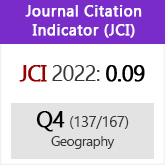Polylepis tarapacana forests in Maure basin, southern Peru. Opportunities for its conservation
DOI:
https://doi.org/10.3989/estgeogr.202071.071Keywords:
Polylepis, remote sensing, cover, conservation, morphometry, natural protected areasAbstract
Despite the importance of Polylepis forests for biodiversity and the environmental services provision in the southern Peruvian Altiplano (Tacna department), there is no updated scientific information to support effective conservation activities. Through remote sensing techniques the surface of Polylepis tarapacana forests in the Maure basin has been mapped and the main environmental factors were evaluated. The forest area obtained was compared with environmental factors such as altitude, climate, orientation and topographic protection. Unlike other Polylepis forests, the dominant orientation of Polylepis tarapacana patches is N-NE-E, exposed to solar insolation before the noon, and developing in areas with low morphometric protection and negative topographical wetness index (low probabilities to meet with shallow groundwater tables). 56,66% of the area obtained intercepts the Polylepis polygon of the 2018 National Map of Ecosystems of Peru, 30,12% is under regional conservation modality and 74,49% is located within the territories of six rural communities. This research generates a more precise forest polygon than those currently available, and allows the evaluation of alternatives for its protection. The expansion of the Regional Conservation Area Vilacota - Maure emerges as the best option to ensure the preservation of this forest, since it ensures the protection of almost all of the identified area.
Downloads
References
Aybar, C., Lavado-Casimiro, W., Huerta, A., Fernández, C., Vega, F., Sabino, E., & Felipe-Obando, O. (2017). Uso del Producto Grillado "PISCO" de precipitación en Estudios, Investigaciones y Sistemas Operacionales de Monitoreo y Pronóstico Hidrometeorológico. Lima, Perú.
Azócar, A., Rada, F., y García-Núñez, C. (2007). Functional characteristics of the arborescent genus Polylepis along a latitudinal gradient in the high Andes. Interciencia, 32, 663-668.
Belgiu, M., y Drăguţ, L. (2016). Random forest in remote sensing: A review of applications and future directions. ISPRS Journal of Photogrammetry and Remote Sensing, 114, 24-31. https://doi.org/10.1016/j.isprsjprs.2016.01.011
Brako, L., y Zarucchi, J. (1993). Catalogue of the Flowering Plants and Gymnosperms of Peru. St. Louis, Mo.: Jardín Botánico de Missouri. 1286p.
Breiman, L. (2001). Random Forests. Machine Learning, 45(1), 5-32. https://doi.org/10.1023/A:1010933404324
Camel, V., Quispe-Melgar, H., Ames-Martínez, F., Navarro, W., Segovia-Salcedo, C., y Kessler, M. (2019). Forest structure of three endemic species of the genus Polylepis ( Rosaceae ) in central Peru. Ecologia Austral, 30, 1-16.
Canedo Rosso, C., Hochrainer-Stigler, S., Pflug, G., Condori, B., y Berndtsson, R. (2018). Early warning and drought risk assessment for the Bolivian Altiplano agriculture using high resolution satellite imagery data. Natural Hazards and Earth System Sciences Discussions, (May), 1-23. https://doi.org/10.5194/nhess-2018-133
Cochi Machaca, N., Condori, B., Rojas Pardo, A., Anthelme, F., Meneses, R. I., Weeda, C. E., & Perotto-Baldivieso, H. L. (2018). Effects of grazing pressure on plant species composition and water presence on bofedales in the Andes mountain range of Bolivia. Mires and Peat, 21, 1-15.
Cuyckens, G. A. E., Christie, D. A., Domic, A. I., Malizia, L. R., y Renison, D. (2016). Climate change and the distribution and conservation of the world's highest elevation woodlands in the South American Altiplano. Global and Planetary Change, 137(July 2018), 79-87. https://doi.org/10.1016/j.gloplacha.2015.12.010
Decreto Supremo Nº043-2006-AG. (2006). Aprueban categorización de especies amenazadas de flora silvestre. Diario Oficial El Peruano, Lima, Perú, 13 de julio del 2006.
Dourojeanni, P. (2008). Distribución y conectividad de bosques altoandinos (Polylepis) en la cuenca alta del río Pativilca. Tesis de Maestría, Pontificia Universidad Católica del Perú, Escuela de Geografía. Recuperado de: http://tesis.pucp.edu.pe/repositorio/handle/20.500.12404/628
Espurt, N., Baby, P., Brusset, S., Roddaz, M., Hermoza, W., y Barbarand, J. (2009). The Nazca Ridge and Uplift of the Fitzcarrald Arch: Implications for Regional Geology in Northern South America. In Amazonia: Landscape and Species Evolution (pp. 89-100). Wiley-Blackwell Publishing Ltd. https://doi.org/10.1002/9781444306408.ch6
Etter, A., y Villa, L. A. (2000). Andean Forests and Farming Systems in part of the Eastern Cordillera (Colombia). Mountain Research and Development, 20(3), 236-245. https://doi.org/10.1659/0276-4741(2000)020[0236:AFAFSI]2.0.CO;2
Fjeldså, J., y Kessler, M. (1996). Conserving the biological diversity of Polylepis forests of the highlands of Peru and Bolivia: a contribution to sustainable natural resource management in the Andes. Copenhagen: Nordic Foundation for Development and Ecology (NORDECO).
Fletcher, C. J. N., Hawkins, M. P., y Tejada, R. (1989). Structural control and genesis of polymetallic deposits in the Altiplano and Western Cordillera of southern Peru. Journal of South American Earth Sciences, 2(1), 61-71. https://doi.org/10.1016/0895-9811(89)90027-8
Gareca, E. E., Breyne, P., Vandepitte, K., Cahill, J. R. A., Fernandez, M., y Honnay, O. (2013). Genetic diversity of Andean Polylepis (Rosaceae) woodlands and inferences regarding their fragmentation history. Botanical Journal of the Linnean Society, 172(4), 544-554. https://doi.org/10.1111/boj.12055
Gareca, E. E., Hermy, M., Fjeldså, J., y Honnay, O. (2010). Polylepis woodland remnants as biodiversity islands in the Bolivian high Andes. Biodiversity and Conservation, 19(12), 3327-3346. https://doi.org/10.1007/s10531-010-9895-9
Garreaud, R., Vuille, M., y Clement, A. C. (2003). The climate of the Altiplano: observed current conditions and mechanisms of past changes. Palaeogeography, Palaeoclimatology, Palaeoecology, 194(1), 5-22. https://doi.org/10.1016/S0031-0182(03)00269-4
Gobierno Regional de Tacna. (2014). Plan de Desarrollo Regional Concertado hacia el 2021. Tacna: Gobierno Regional de Tacna. 120p.
Griffiths, R., Madritch, M., y Swanson, A. K. (2009). The effects of topography on forest soil characteristics in the Oregon Cascade Mountains (USA): Implications for the effects of climate change on soil properties. Forest Ecology and Management, 257, 1-7. https://doi.org/10.1016/j.foreco.2008.08.010
Hijmans, R. J. (2019). raster: Geographic Data Analysis and Modeling. Retrieved from https://cran.r-project.org/package=raster
Himley, M. (2009). Nature conservation, rural livelihoods, and territorial control in Andean Ecuador. Geoforum, 40(5), 832-842. https://doi.org/10.1016/j.geoforum.2009.06.001
Kessler, M. (2006). Bosques de Polylepis. En: Moraes M., B. Øllgaard, L.P. Kvist, F. Borchsenius and H. Balslev (Eds.) Botánica Económica de los Andes Centrales. Universidad Mayor de San Andrés, La Paz. pp: 110-120.
Martínez-Cruz, A. L., Juárez-Torres, M., & Guerrero, S. (2017). Assessing Impacts From Climate Change on Local Social-ecological Systems in Contexts Where Information is Lacking: An Expert Elicitation in the Bolivian Altiplano. Ecological Economics, 137, 70-82. https://doi.org/10.1016/j.ecolecon.2017.03.003
Mendoza, W., y Cano, A. (2011). Diversidad del género Polylepis (Rosaceae, Sanguisorbeae) en los Andes peruanos. Revista Peruana de Biologia, 18(2), 197-200. https://doi.org/10.15381/rpb.v18i2.228
MINAM. (2015). Mapa nacional de cobertura vegetal: Memoria descriptiva/ Ministerio del Ambiente, Dirección general evaluación, valoración y financiamiento del patrimonio natural. Lima-Perú.
MINAM. (2018). Mapa nacional de ecosistemas del Perú: Memoria descriptiva/ Ministerio del Ambiente, Dirección de monitoreo y de Evaluación de los recursos naturales del territorio. Lima-Perú.
Morales, M. S., Christie, D. A., Villalba, R., Argollo, J., Pacajes, J., Silva, J. S., Soliz Gamboa, C. C. (2012). Precipitation changes in the South American Altiplano since 1300 AD reconstructed by tree-rings. Climate of the Past, 8(2), 653-666. https://doi.org/10.5194/cp-8-653-2012
Moya, J., y Lara, A. (2011). Cronologías de ancho de anillos de queñoa (Polylepis tarapacana) para los últimos 500 años en el Altiplano de la región de Arica y Parinacota, Chile. Bosque, 32(2), 165-173. https://doi.org/10.4067/S0717-92002011000200007
Olaya, V. (2009). Chapter 6 Basic Land-Surface Parameters. In T. Hengl y H. I. Reuter (Eds.), Geomorphometry (Vol. 33, pp. 141-169). Elsevier. https://doi.org/10.1016/S0166-2481(08)00006-8
Olaya, V., y Conrad, O. (2009). Chapter 12 Geomorphometry in SAGA. In T. Hengl y H. I. Reuter (Eds.), Geomorphometry (Vol. 33, pp. 293-308). Elsevier. https://doi.org/10.1016/S0166-2481(08)00012-3
Ordenanza Regional Nº 016-2012-CR/GOB.REG.TACNA. (2013). Aprueban la Zonificación Ecológica y Económica de Tacna. Diario Oficial El Peruano, Lima, Perú, 18 de enero del 2013.
R Core Team. (2019). R: A Language and Environment for Statistical Computing. Vienna, Austria. Retrieved from https://www.r-project.org/
Rau, P., Bourrel, L., Labat, D., Melo, P., Dewitte, B., Frappart, F., Felipe, O. (2017). Regionalization of rainfall over the Peruvian Pacific slope and coast. International Journal of Climatology, 37(1), 143-158. https://doi.org/10.1002/joc.4693
Ríos, S. (1998) Estudio de la distribución y caracterización ecológica de las poblaciones locales de queñoa de altura (Polylepis tarapacana Phil.) en el sector de la provincia de Iquique. Tarapacá. Chile. Memoria Ing. Forestal. Universidad de Chile. Facultad de Ciencias Agrarias y Forestales. 61 pp.
Ritter, B., Wennrich, V., Medialdea, A., Brill, D., King, G., Schneiderwind, S., … Dunai, T. J. (2019). "Climatic fluctuations in the hyperarid core of the Atacama Desert during the past 215 ka." Scientific Reports, 9(1), 5270. https://doi.org/10.1038/s41598-019-41743-8 PMid:30918294 PMCid:PMC6437205
Sarricolea, P., Herrera-Ossandon, M., y Meseguer-Ruiz, Ó. (2017). Climatic regionalisation of continental Chile. Journal of Maps, 13(2), 66-73. https://doi.org/10.1080/17445647.2016.1259592
Servat, G. P., Mendoza, W., y Ochoa, J. A. (2002). Flora y fauna de cuatro bosques de Polylepis (Rosaceae) en la cordillera de Vilcanota (Cusco, Peru). Ecología Aplicada, 1(1), 25-35. https://doi.org/10.21704/rea.v1i1-2.226
SIAR-Tacna. (2009). Elaboración de estudios técnicos para la definición de sitios prioritarios, análisis de conectividad y definición de indicadores de representatividad y conectividad - componente biodiversidad (I Informe). Sistema de Información Ambiental Regional (SIAR), Gobierno Regional de Tacna. Tacna-Perú
Toivonen, J. M., Gonzales-Inca, C. A., Bader, M. Y., Ruokolainen, K., y Kessler, M. (2017). Elevational shifts in the topographic position of Polylepis forest stands in the Andes of Southern Peru. Forests, 9(1), 1-10. https://doi.org/10.3390/f9010007
Tuia, D., Pasolli, E., y Emery, W. J. (2011). Using active learning to adapt remote sensing image classifiers. Remote Sensing of Environment, 115(9), 2232-2242. https://doi.org/10.1016/j.rse.2011.04.022
USGS. (2019). Earth Explorer, United States Geological Service. Recuperado de https://earthexplorer.usgs.gov
Valdivia, C., Thibeault, J., Gilles, J. L., García, M., y Seth, A. (2013). Climate trends and projections for the Andean Altiplano and strategies for adaptation. Advances in Geosciences, 33, 69-77. https://doi.org/10.5194/adgeo-33-69-2013
Valencia, B. G., Gosling, W. D., Bush, M. B., Coe, A. L., y Orren, E. (2018). Polylepis woodland dynamics during the last 20000 years, 1019-1030. https://doi.org/10.1111/jbi.13209
Vicente-Serrano, S. M., Chura, O., López-Moreno, J. I., Azorin-Molina, C., Sanchez-Lorenzo, A., Aguilar, E., ... Nieto, J. J. (2015). Spatio-temporal variability of droughts in Bolivia: 1955-2012. International Journal of Climatology, 35(10), 3024-3040. https://doi.org/10.1002/joc.4190
Yager, K., Valdivia, C., Slayback, D., Jimenez, E., Meneses, R., Palabral-Aguilera, A., ... Romero, A. (2019). Socio-ecological dimensions of Andean pastoral landscape change: bridging traditional ecological knowledge and satellite image analysis in Sajama National Park, Bolivia. Regional Environmental Change, 19, 1353-1369. https://doi.org/10.1007/s10113-019-01466-y
Zutta, B. R., y Rundel, P. W. (2017). Modeled shifts in Polylepis species ranges in the Andes from the last glacial maximum to the present. Forests, 8(7), 1-16. https://doi.org/10.3390/f8070232
Zutta, B. R., Rundel, P. W., Saatchi, S., Casana, J. D., Gauthier, P., Soto, A., ... Buermann, W. (2012). Prediciendo la distribución de Polylepis: bosques Andinos vulnerables y cada vez más importantes. Revista Peruana de Biología, 19(2), 205-212. https://doi.org/10.15381/rpb.v19i2.849
Published
How to Cite
Issue
Section
License
Copyright (c) 2021 Consejo Superior de Investigaciones Científicas (CSIC)

This work is licensed under a Creative Commons Attribution 4.0 International License.
© CSIC. Manuscripts published in both the printed and online versions of this Journal are the property of Consejo Superior de Investigaciones Científicas, and quoting this source is a requirement for any partial or full reproduction.All contents of this electronic edition, except where otherwise noted, are distributed under a “Creative Commons Attribution 4.0 International” (CC BY 4.0) License. You may read here the basic information and the legal text of the license. The indication of the CC BY 4.0 License must be expressly stated in this way when necessary.
Self-archiving in repositories, personal webpages or similar, of any version other than the published by the Editor, is not allowed.
















